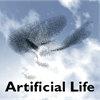环境变化分布对人工生命模拟的影响
IF 1.6
4区 计算机科学
Q4 COMPUTER SCIENCE, ARTIFICIAL INTELLIGENCE
引用次数: 1
摘要
众所周知,环境变化对真实的进化有很大的影响,在进化的人工生命模拟中也发现了类似的影响。特别是,关于各种进化结果如何依赖于代表环境变化的噪声分布,以及模型使用具有正确噪声颜色的逆幂律分布的重要性,已经进行了大量的研究。然而,有两个截然不同的相关因素——单位时间内变化的平均总幅度和个别变化幅度的分布——如果这些因素没有适当地分开,可能会出现误导性的结果。本文利用现有的基于智能体的人工生命建模框架,使用以前为其他目的尝试和测试过的模型来探索这个问题。本文首先展示了总幅度和分布效应是如何容易混淆的,然后展示了如何通过使用基于相关性的规范化来理清这些相互作用因素的影响。然后给出了一系列模拟结果,表明在分离这些因素后,对噪声分布的有趣依赖关系仍然存在,但是涉及逆幂律分布的噪声颜色的许多影响消失了,并且在限制范围的白噪声分布中出现了非常相似的结果。发现单位时间内的平均总变化幅度对模拟结果有实质性影响,但个体变化的分布影响很小。因此提供了一个强有力的反例,证明在人工生命模型中使用准确的环境变化分布总是很重要的。本文章由计算机程序翻译,如有差异,请以英文原文为准。
Effect of Environmental Change Distribution on Artificial Life Simulations
It is already well known that environmental variation has a big effect on real evolution, and similar effects have been found in evolutionary artificial life simulations. In particular, a lot of research has been carried out on how the various evolutionary outcomes depend on the noise distributions representing the environmental changes, and how important it is for models to use inverse power-law distributions with the right noise colour. However, there are two distinct factors of relevance—the average total magnitude of change per unit time and the distribution of individual change magnitudes—and misleading results may emerge if those factors are not properly separated. This article makes use of an existing agent-based artificial life modeling framework to explore this issue using models previously tried and tested for other purposes. It begins by demonstrating how the total magnitude and distribution effects can easily be confused, and goes on to show how it is possible to untangle the influence of these interacting factors by using correlation-based normalization. It then presents a series of simulation results demonstrating that interesting dependencies on the noise distribution remain after separating those factors, but many effects involving the noise colour of inverse power-law distributions disappear, and very similar results arise across restricted-range white-noise distributions. The average total magnitude of change per unit time is found to have a substantial effect on the simulation outcomes, but the distribution of individual changes has very little effect. A robust counterexample is thereby provided to the idea that it is always important to use accurate environmental change distributions in artificial life models.
求助全文
通过发布文献求助,成功后即可免费获取论文全文。
去求助
来源期刊

Artificial Life
工程技术-计算机:理论方法
CiteScore
4.70
自引率
7.70%
发文量
38
审稿时长
>12 weeks
期刊介绍:
Artificial Life, launched in the fall of 1993, has become the unifying forum for the exchange of scientific information on the study of artificial systems that exhibit the behavioral characteristics of natural living systems, through the synthesis or simulation using computational (software), robotic (hardware), and/or physicochemical (wetware) means. Each issue features cutting-edge research on artificial life that advances the state-of-the-art of our knowledge about various aspects of living systems such as:
Artificial chemistry and the origins of life
Self-assembly, growth, and development
Self-replication and self-repair
Systems and synthetic biology
Perception, cognition, and behavior
Embodiment and enactivism
Collective behaviors of swarms
Evolutionary and ecological dynamics
Open-endedness and creativity
Social organization and cultural evolution
Societal and technological implications
Philosophy and aesthetics
Applications to biology, medicine, business, education, or entertainment.
 求助内容:
求助内容: 应助结果提醒方式:
应助结果提醒方式:


